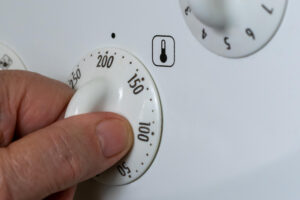Sample (Simple) Energy Plan
Last updated on March 10th, 2024 at 03:20 pm
60%Â savings on the electric bill, and 35% off gas/heating bill…read how it was done.
After a previous brutally cold winter, our first focus was the windows. They were in sorry shape, with the window pane itself damaged and the frame warping away. Many were so bad that the windows themselves couldn’t be opened. They simply would not slide up and down.
The screens were in bad shape too, as well the storm windows. We had previously covered up the problem by placing plastic over the window, but we realized the problem was beyond that repair when the plastic would move violently in the house when a good strong breeze was blowing outside.
There were several leaks in the windows, and it was beyond repair. So we swallowed the cost of having 6 new windows installed. The total cost was around $2000.
This, it turned out, was a major factor in getting the heating cost reduced. There were no more heat holes around the windows at all. Even on the breezy days, we feel no wind while sitting by the window.
For the windows that were not replaced, I picked up a tube of caulk and patched gaps and holes that I found in the frame, moulding, and between the glass and frame. The caulk dries best when in a moderate temperature, so I was glad I did this before we had any major cold spells.
Our doors were also atrocious. Unfortunately since we replaced the windows we couldn’t afford to replace the doors right away. So, I caulked around the frame and wall where there were gaps, and installed foam tape insulation to fill the gaps between the door and the frame. I made sure the door still opened and closed without a problem.
The door sweeps were worn out, so I used absorbent towels to block out the cold air, especially at night before I went to bed.
Our household went through a couple of habit changes as well. Any room that was not used had the door to it shut all the time. I installed a setback or programmable thermostat early in the season and programmed it immediately. It took me about 2 weeks to get fully comfortable with the programming and schedules.
Every 30 days during the cold season, I changed the furnace filter. (Wow, was it dirty every single time!)
We bought new furniture, so I took the opportunity to re-arrange the living room. While doing this, I unblocked the heat vent as well as the return vent.
Finally, the door to the unheated basement was kept closed. While in the basement, I insulated the hot water heater and the delivery pipes.
Add all those things up, and you have a pretty nice savings. For me it was about 35% off my heating bills for the same time period last year, before I implemented any changes.
Let’s move on to electricity.
Even though I saved more, the steps I took were even simpler.
I bought a single fluorescent light, just to try it out. I replaced the incandescent hallway light with the new fluorescent one, and actually liked the look.
So did my wife.
So I bought a six pack of the bulbs. The six bulbs cost me about $15. I replaced the bedroom lights, remaining hallway light, and kitchen light with the new fluorescent ones.
Then I replaced the outdoor porch light with a special outdoor fluorescent light.
(By the way, all the lights I bought up to this point were 14 watt fluorescent bulbs with a lifespan of 8000 hours – over 8 times the lifespan of a traditional bulb. They all gave off the same light as a 60 watt bulb.)
Then I replaced the bathroom globe lights with the special fluorescent globes made to withstand moisture.
The lights in the basement were replaced with fluorescents as well.
As it stands, there are only 4 lights in the house that are not fluorescent. And they’re all on dimmers.
Every time a light in a room isn’t in use, it gets turned off. No questions asked, no doubts about it. When we leave to go out, I leave one light on – the hallway fluorescent.
All appliances, like coffeemakers and extra VCR’s that weren’t used on a daily basis were unplugged.
Every electronics device, including my computers in my home office, were placed on power strips and switched off when not used.
I also significantly reduced the use of my desktop computer and use my laptop much more, which uses about 1/5 of the power.
And finally, we cut down on TV usage.
Believe it or not, this is all it took to save about 60% on my electric bill.
Appendix E, from the “Reducing Utility Bills” ebook.



Thanks for posting, I’ll definitely be subscribing to your blog.
I really like your post. Does it copyright protected?
Hey, great post, very well written. You should blog more about this. I’ll definitely be subscribing.
Original post by Dmitri Gromov
Hello, can you please post some more information on this topic? I would like to read more.
Hey, nice post, really well written. You should blog more about this.
power strips are very useful but they octopus connection is dangerous,:*
sometimes power strips can overheat specially if they are poorly designed-,,
just buy high quality power strips and do not use power strips that are not UL certified ‘